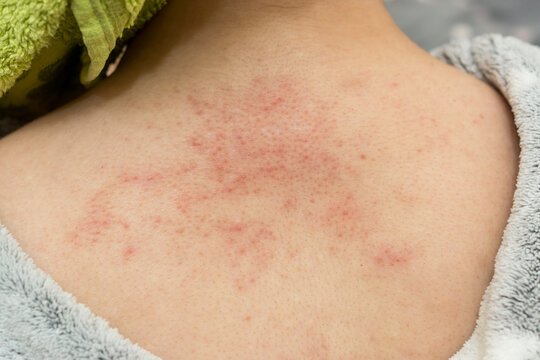Heat rash, also known as prickly heat or miliaria, is a common skin condition that occurs when sweat ducts become blocked, leading to inflammation and the development of a rash. It typically occurs in hot and humid weather conditions or when there is excessive sweating. Heat rash can affect people of all ages, but it is more common in infants and young children.
Symptoms
- Small, itchy red bumps: Heat rash is characterized by clusters of small, raised, red bumps on the skin. These bumps may be itchy or prickly, causing discomfort.
- Redness and inflammation: The affected area may appear red and inflamed due to the blocked sweat ducts and the body’s inflammatory response.
- Prickling or stinging sensation: Heat rash can cause a prickling or stinging sensation, especially in areas where sweat accumulates, such as the neck, chest, groin, underarms, or elbow creases.
- Heat intolerance: Heat rash may be accompanied by a decreased ability to tolerate heat, as the blocked sweat ducts impair the body’s natural cooling mechanism.
To buy heat rash creams and other products like hydrozole cream you can visit oladoc.
Types of Heat Rash
- Miliaria Crystallina: This is the mildest form of heat rash, characterized by clear, fluid-filled blisters on the surface of the skin. The blisters may burst easily.
- Miliaria Rubra: Also known as prickly heat, this type of heat rash appears as red bumps or small blisters. It can be accompanied by intense itching or a prickling sensation.
- Miliaria Profunda: This is a less common and more severe form of heat rash. It occurs deeper in the skin and presents as flesh-colored, firm bumps. Miliaria profunda is typically associated with repeated episodes of heat rash.
Causes
- Overheating: Heat rash occurs when the body overheats due to hot and humid weather conditions, or when there is excessive sweating. The sweat ducts become blocked, preventing sweat from reaching the surface of the skin.
- Immature sweat ducts: In infants, the sweat ducts are not fully developed, making them more prone to blockages and heat rash.
- Occlusion: Wearing tight or non-breathable clothing that traps sweat against the skin can contribute to the development of heat rash.
- Physical activity: Engaging in activities that cause excessive sweating, such as intense workouts or sports, increases the risk of heat rash.
Prevention and Treatment
- Stay cool: Avoid hot and humid environments when possible. Seek shade, use fans, or air conditioning to maintain a cool temperature.
- Dress appropriately: Wear loose-fitting, lightweight, and breathable clothing to allow proper ventilation and reduce sweating.
- Keep the skin dry: Pat the skin gently with a soft towel to remove excess sweat and moisture.
- Use topical treatments: Calamine lotion or over-the-counter hydrocortisone cream can help alleviate itching and reduce inflammation.
- Avoid harsh soaps: Use mild, fragrance-free soaps and avoid excessive scrubbing, as this can irritate the skin further.
- Stay hydrated: Drink plenty of fluids to prevent dehydration and aid in maintaining normal body temperature.
- Seek medical attention: If the heat rash persists, worsens, or becomes infected, or if you develop a fever, consult a healthcare professional for further evaluation and treatment.
Conclusion
Heat rash is a common skin condition characterized by blocked sweat ducts and the development of a rash. It occurs due to overheating, excessive sweating, and hot and humid weather conditions. Taking measures to stay cool, wearing appropriate clothing, and keeping the skin dry can help prevent and manage heat rash. Visit your doctor in case your condition does not improve as they can prescribe you medications for relief. You can buy medicines like clobevate cream and others online or from a pharmacy.


